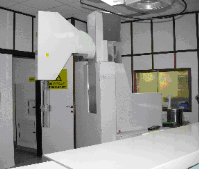
|
The IORT-1 system during the installation at the Azienda Ospedaliera di Cosenza in January of 2005 |
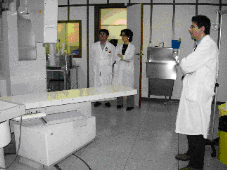
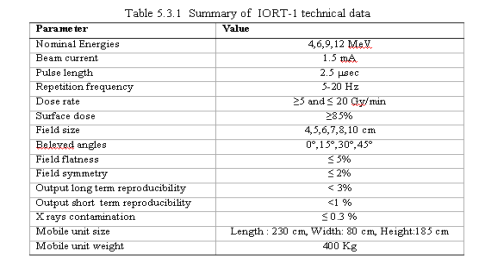
|
Figure above shows the machine during the installation in the hospital: it consists of a mobile radiant unit and a operator control rack, connected by a 10 meters cable, which during the irradiation supplies the radiant unit with electrical power and transmits the treatment parameters. The output beam is collimated by a sterilizable cylindrical perspex applicator, which is 60 cm long and can have different diameters (4,5,6,7,8,10 cm) and terminal beveled angles (0°,15°,30°,45°). The radiant head is a standing wave S-band, b graded, autofocusing (no external focusing solenoid is needed) linear accelerating structure, specifically designed by ENEA. The single cavities shape, optimized in order to maximize the efficiency and to reduce the dark currents, has been patented. An innovative robotic system with 5 DOF (degrees of freedom) manufactured by the Italian Co. INFO&TECH allows the IORT-1 to be extremely moveable. IORT-1 radiant unit weight is less than 400 Kg, so that there are not installation problems in any surgical suite. Due to the increasing interest on this technique, characterized by a very high local control with a very low toxicity level, ENEA during 2005 started the study of an advanced IORT system based on the use of a linear accelerator with variable energy up to18 MeV, operating in C band (5712 MHz). Respect to the accelerators used in the commercial IORT systems operating at a typical frequency of 2998 MHz (S band) limited to a maximum energy of 12 MeV, the use of a higher RF frequency allows an increase of the maximum energy. This gives the possibility to extend the use of the IORT technique to a wider field of tumors and to get an improvement in terms of compactness and weight reduction. In addition it has been foreseen to provide the machine with a devoted absolute dosimetry system that will strongly simplify the procedures of dosimetric characterization. |

|
Medical applications of Accelerators: IORT and PBRT |
|
ELECTRON ACCELERATORS |
|
Home |
|
TOP IMPLART |
|
Electron Accelerators |
|
Contacts and Links |
|
FSN - TECFIS - APAM Particle Accelerators and Medical Applications Laboratory |

|
ENEA ACCESSIBILITA’ CONTATTI |
|
IORT: IntraOperative Radiation Therapy |
|
Intraoperative radiotherapy (IORT) consists in delivering a large single dose to a surgically exposed tumor bed, while minimizing dose to normal tissues. The technical advantages of IORT consist in the direct visual control of the target volume and in the possibility to protect the healthy tissue by moving them away from the path of the radiation beam. In early ‘90s ENEA and the Italian Co. HITESYS (that benefitted from a technology transfer in the accelerator field by ENEA in the years 1985-1990) developed the first concept of the modern IntraOperative Radiation system unit, that has the possibility to perform the irradiation directly in the operating room without particular fixed shielding barriers. This simplfies the irradiation technique, without interrupting the surgery and bringing the patient in the RT vault for irradiation and then complete the operation, with the consequence of diffusing IORT in hospitals. After the first one, HITESYS (then NRT and now SIT) was able to sell about 15 more units named NOVAC7, still in production by NRT, that took over HITESYS in 2005) up to 2003 Therefore an evolution of the NOVAC7 system was developed by ENEA in the framework of the IORT Project funded by the Italian Ministry of University and Research (MIUR). This new-generation, IORT-1 was taken as reference by the company INFO&TECH for their generation of systems, named LIAC (see figure below) |
|
In the framework of the ENEA Project TECHEA (TEChnology for HEAlth) launched at the end of 2018 the APAM laboratory is developing a dedicated self-shielded system for the treatment of breast cancer (Partial Breast Ittadiation) with the patient placed in prone position based on a small S-band 3 MeV electron linear accelerator. It consists on a small radiation source of photon beam rotating around a vertical axis under a carbon fiber dedicated table with a circular opening through which the breast hangs down. This arrangment is condidered to improved local tumor control and not to lead to adjunctive acute e late toxicity.
Expected results: increase of treatment accessibility and reduction of radiotherapy waiting time reduction of installation and implementation costs
General Parameters of the accelerator Gun energy: 15 keV Repetition frequency 200 Hz Pulse current 180 mA Pulse duration 4 us Max. energy 3 MeV Source isocenter distance 60 cm Spot radius 1 mm Target material W Power density on target 50 W/mm3 |
|
PBRT (Partial Breast Radiation Therapy) |
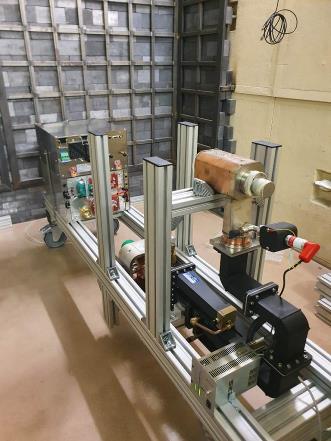
|
System under assembly in a test bunker at ENEA-Frascati |
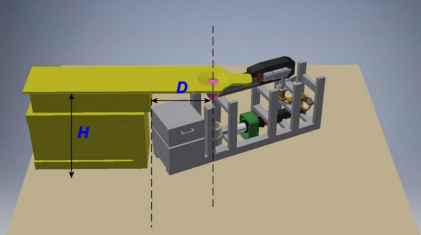
|
System design |